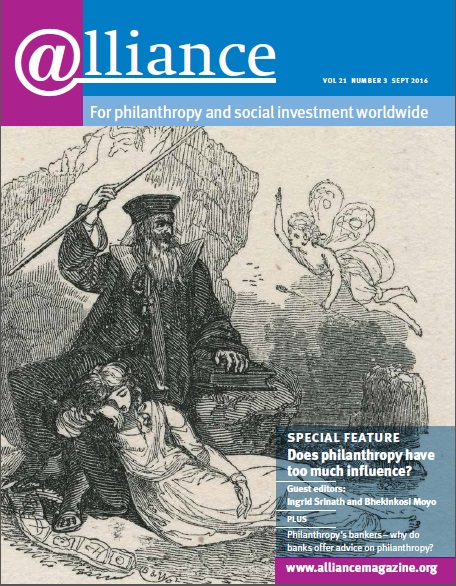As I write these words, news headlines in India are dominated by two themes: on the one hand, a growing wave of protest, from widespread student unrest and caste-based mobilizations to renewed militancy in Kashmir; on the other, celebration as well as criticism of the impact of 25 years of economic liberalization. As in so many countries around the world, political polarization, social illiberalism and widening inequality are confronting greater access to information, more impatience with the pace of change and a vastly heightened sense of agency.
Its unique geopolitical position, robust economic growth and rich democratic traditions provide India with the opportunity to pioneer the transformational economic, social and political models the world so urgently demands. Indian philanthropy can do much more to facilitate the spaces and strengthen the institutions that will foster the dialogues, partnerships and innovations that are needed.
‘Its unique geopolitical position, robust economic growth and rich democratic traditions provide India with the opportunity to pioneer the transformational economic, social and political models the world so urgently demands.’
The changing face of Indian philanthropy
As the nature, spread and drivers of wealth in India have changed over the past two and a half decades so too, inevitably, has philanthropy. Much traditional philanthropy in India had emphasized nation building, furnishing the then newly independent republic with academic, scientific and cultural institutions. Alleviating the condition of India’s poverty-stricken millions through delivering services – basic education, health, care for the elderly, the indigent and the infirm – was another key philanthropic priority. Substantial sums were also dedicated to faith-based work and to the welfare of particular communities.
The new wealth – especially that generated in the technology and financial services industries, which boomed following the liberalization of the economy – has tended to be more individualistic, mainly focused on education, often with a technocratic bent, informed as much by the philanthropist’s personal worldview as by the needs of those they might seek to serve. Like the industries where this wealth is being created, the hallmarks of this philanthropy are scale, efficiency, return on capital and an emphasis on impact measurement.
‘As Indian business has with its adoption of technology, so Indian philanthropy has sought to leapfrog the evolutionary patterns of its northern counterparts. It has been relatively less enthusiastic, however, about overtly seeking greater influence over policy, focusing instead on a theory of change that hopes that building a better mousetrap will result in scale via adoption by government or by the market.’
As Indian business has with its adoption of technology, so Indian philanthropy has sought to leapfrog the evolutionary patterns of its northern counterparts. It has been relatively less enthusiastic, however, about overtly seeking greater influence over policy, focusing instead on a theory of change that hopes that building a better mousetrap will result in scale via adoption by government or by the market. In keeping with values that still pay some respect to Gandhian principles, it has also been less visible and less self-congratulatory than some of its western counterparts.
India is a country where over 200 million children are malnourished; over half a million girls are lost to foeticide, infanticide or neglect each year; learning outcomes in the school system are abysmal and declining; threats to the environment loom ever larger; policy and its implementation are fragmented over 29 states and 7 union territories and dozens of ministries and departments; and civil society space is coming under increasing constraints. Against this background, Indian philanthropy could, and increasingly does, seek to support causes and organizations with high leverage – governance reform and independent media, as well as research, capacity building and networking in civil society, for instance.
On the frontiers of Indian philanthropy
My fellow contributors to this section of Alliance exemplify some of the most promising emerging trends. They combine humility in their recognition of the limitations of private philanthropy with boldness in the scale and complexity of the issues they seek to redress. They are conscious of the vast gaps in traditional giving and often choose to zig when everyone else is zagging. Each aims not just to ‘give from the heart’ but also to create and sustain world-class institutions, networks and platforms. All are demonstrably reflective, thoughtful givers who are not slaves to simplistic metrics or rigid ideology.
Much higher impact and greater multiplier effects, as well as continued legitimacy, will depend on the capacity and willingness of their fellow philanthropists to emulate their efforts in working collaboratively, building platforms rather than individual apps and adopting greater transparency in all aspects of their philanthropic work. Recent examples – including the collective philanthropic initiatives that created the Ashoka University, of which Amit Chandra is a part; the Independent and Public Spirited Media Trust, which is supported by Rohini Nilekani, Azim Premji Philanthropic Initiatives and others; and the governance fund initiated by Dasra – are promising. The relative lack of visible support for more politically sensitive causes and for civil society itself, however, remains a significant lacuna.
The spurt in corporate giving mandated by a recent law requiring large businesses to direct 2 per cent of net income towards philanthropic ends; the spread of the culture of ‘giving back’ among the newly wealthy; new benchmarks for both volume and timelines for sharing individual wealth; continuing economic growth and rapidly growing ‘retail’ philanthropy from India’s burgeoning middle classes – when combined, these may portend the philanthropic renaissance that Amit Chandra highlights.
‘The future of groups whose work is neither photogenic nor popular in government and business circles is less certain – likewise, those who target the roots of the privilege on which so much philanthropy is built, or those who defend basic constitutional freedoms and their defenders.’
Backing the unpopular
As Amitabh Behar and Rohini Nilekani both note, however, the future of groups whose work is neither photogenic nor popular in government and business circles is less certain – likewise, those who target the roots of the privilege on which so much philanthropy is built, or those who defend basic constitutional freedoms and their defenders. Or the organizations and activists who monitor India’s role in international institutions and negotiations. Some of these have sustained themselves entirely through local support from members and allies. Others eschew support from foundations and businesses as a matter of principle. But many have depended on funding from international donors that is increasingly constrained by the atmosphere of suspicion, hostility and, in some cases, outright persecution, to which Anantha Padmanabhan and Tasqeen Macchiwalla allude.
Strengthening the institutions to foster the dialogues and partnerships needed to cut through this atmosphere will take vision, humility and courage from India’s philanthropists if they are to jointly and individually galvanize, amplify, disrupt and enable civil society to deliver transformative change of the necessary scale and pace. It will require them to play to philanthropy’s distinctive strengths – providing patient risk capital unswayed by the cycles of politics and markets, resourcing the institutional ecosystem that nurtures democratic rights and freedoms, and shining a light on the darkest corners of Indian society. Most significantly, it will require clear-eyed understanding of the potential for philanthropic impact and the checks and balances necessary to sustain its legitimacy.
Ingrid Srinath is the founder director of the Centre for Social Impact and Philanthropy at the Ashoka University. Email ingrid.srinath@gmail.com









Comments (0)